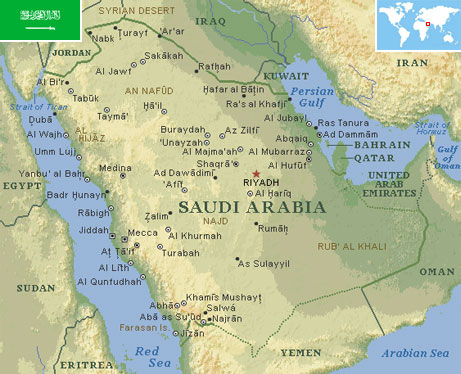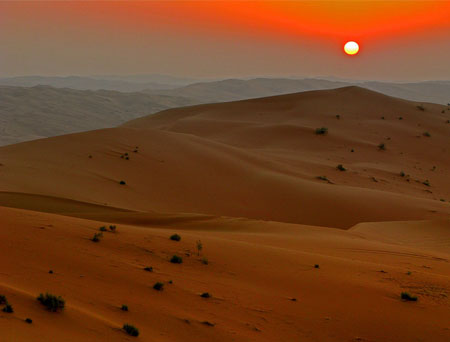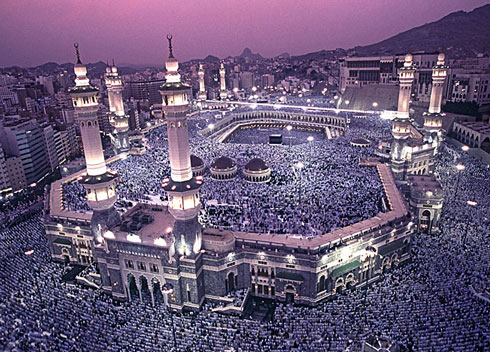Saudi Arabia
Country statistics

Land area: 756,981 sq miles (1,960,582 sq km)
Population (2012 est.): 26,534,504 (growth rate: 1.52%); birth rate: 19.19/1000; infant mortality rate: 15.61/1000; life expectancy: 74.35; density per sq miles: 31
Capital City: Riyadh
Monetary unit: Riyal
Languages: Arabic
Ethnicity/race: Arab 90%, Afro-Asian 10%
Religions: Islam 100%
Country introduction

Saudi Arabia is a country situated in South-west Asia and occupies most of the Arabian Peninsula, with the Red Sea and the Gulf of Aqaba to the west and the Persian Gulf to the east. Neighboring countries are Jordan, Iraq, Kuwait, Qatar, the United Arab Emirates, the Sultanate of Oman, Yemen, and Bahrain, connected to the Saudi mainland by a causeway.
The kingdom occupies 80% of the Arabian Peninsula. Most of the country's boundaries with the United Arab Emirates, Oman, and Yemen are undefined, so the exact size of the country remains unknown.
The climate is dry and hot. The land is occupied with dry deserts of great extremes of temperature, and the terrain is mostly uninhabited with sandy deserts. In most parts of the country, vegetation is limited to weeds, xerophytic herbs and shrubs. Animals include the ibex, wildcats, baboons, wolves, and hyenas in the highlands. Small birds are found in the oases. The coastal area of the Red Sea, especially the coral reefs, have a rich marine fauna. Saudi Arabia has a coastline of 2,640 km (1,640 miles).
Saudi Arabia consists mostly of semi-desert and desert with oases. Almost half of the total country is uninhabitable desert with annual precipitation up to 100 mm (4 in) in most regions. The western regions are plateau and the east is lowland. The south-west region has mountains as high as 3,000 m (9,840 ft), and is an area known for the greenest and freshest climate in all of the country. The capital, Riyadh, which is to the center-east has an average temperature in July of 42 °C (108°F) and 14 °C (57 °F) in January. In contrast, Jeddah on the western coast has 31 °C (88 °F) in July and 23 °C (73 °F) in January.
The culture

Saudi Arabian culture revolves almost entirely around the religion of Islam. Islam's two holiest sites, Mecca and Medina, are located in the country. Every day, five times a day, Muslims are called to prayer from the minarets of mosques which dot the country. The weekend consists of Thursday and Friday. The public practice of any religion other than Islam, including Christianity and Judaism, the presence of churches and open possession of Christian religious materials are outlawed in Saudi Arabia. Islam's holy book the Qur'an is Saudi Arabia's constitution, and Shari'ah (Islamic law) is the foundation of its legal system.
The country's only official holidays are the Muslim holy days of Eid ul-Fitr, marking the end of Ramadan, and the lesser-known holiday of Eid al-Adha, held roughly 70 days after Ramadan. Unification of the Kingdom Day, the anniversary of modern Saudi Arabia's 1932 founding, is among the few Saudi holidays held on a set day on the Western calendar instead of the Islamic calendar. The two-week Janadriyah National Festival, held each February, is about as lively as Saudi festivals get.
One of Saudi Arabia's most compelling folk rituals is the Ardha, the country's national dance. This sword dance is based on ancient Bedouin traditions: drummers beat out a rhythm and a poet chants verses while sword-carrying men dance shoulder to shoulder. Al-sihba folk music, from the Hijaz, has its origins in Arab Andalusia, a region of medieval Spain. In Mecca, Medina and Jeddah, dance and song incorporate the sound of the al-mizmar, an oboe-like woodwind instrument. The drum is also an important instrument according to traditional and tribal customs.
Saudi Arabian dress is strongly symbolic, representing the people's ties to the land, the past, and Islam. Traditionally, men usually wear an ankle-length shirt woven from wool or cotton (known as a thawb), with a shimagh (a large checkered square of cotton held in place by a cord coil) or a ghutra(a plain white square made of finer cotton, also held in place by a cord coil) worn on the head. For rare chilly days, Saudi men wear a camel-hair cloak (bisht) over the top. Women's clothes are decorated with tribal motifs, coins, sequins, metallic thread, and appliques. However, Saudi women must wear a long cloak (abaya) and veil (niqab) when they leave the house to protect their modesty.
Islam forbids the eating of pork and the drinking of alcohol, and this law is followed strictly throughout Saudi Arabia. Arabic unleavened bread, or khobz, is eaten with almost all meals. Other staples include cooked lamb, grilled chicken, felafel (deep-fried chickpea balls), shwarma (spit-cooked sliced lamb), and fuul (a paste of fava beans, garlic and lemon). Traditional coffee houses used to be ubiquitous, but are now being displaced by food-hall style cafes. Arabic tea is also a famous custom, which is used in both casual and formal meetings between friends, family and even strangers. The tea is black (without milk) and has herbal flavoring that comes in many variations.
Attractions & landmarks

Saudi Arabia is home to the holiest cities in Islam, Mecca (Makkah in Arabic), which is located 72 km (45 miles) east of Jeddah. A cuboid building called The Kaaba, also known as the Sacred House, is the most sacred sites in Islam. Al-Masjid al-Haram, the most sacred mosque, was built around the Kaaba. Mecca is the center of the Islamic world and the birthplace of both the Prophet Muhammad and the religion he founded. In his late 30s Muhammad took to regularly visiting a cave in Mount Hira, 3.2 km (2 miles) from Mecca to seek solitude and contemplation. The first revelation of the Quran came to him in this cave when he was 40 in 610 AD. Today, 2,000,000 people perform the Hajj each year, and the pilgrimage serves as a unifying force in Islam by bringing together followers from a diverse range of countries and language groups. Every able-bodied Muslim is required to make the pilgrimage at least once in their lifetime. Unfortunately, it is off-limits to non-Muslims.
Medina, is the second holiest city and is also forbidden to non-Muslims. The city is significant in Islamic history for where Muhammad's final religious base was established after the Hijrah and where he died in 632 AD. Medina was the power base of Islam in its first century, being where the early Muslim community (Ummah) developed under the Prophet's leadership. Medina is home to the three oldest mosques, namely Al-Masjid an-Nabawi (The Prophet's Mosque), Quba Mosque (the first mosque in Islam's history), and Masjid al-Qiblatain (The Mosque of the Two Qiblahs - the mosque where the direction of Muslim prayer, or qiblah, was switched from Jerusalem to Mecca).
For non-Muslim, there are plenty of attractions to visit. Tourists are usually attracted to coastal areas such as Jeddah in the west and Dammam and Alkhobar in the east. Areas of natural beauty include Taif, Al Baha and Abha. Other sites are well-known for their historic remains. Nabatean tombs can be found in Madain Salah. Also, hiking and camping in the country's vast deserts are popular activities with many visitors.
Because of its large number of oil-workers and other migrants, Jeddah is the most culturally diverse and tolerant city in Saudi Arabia. Efforts to attract tourists and other visitors have led to numerous and often bizarre works of public art. The famous Jeddah Fountain and the Floating Mosque are also worth seeing. The coral reefs along the coast of the Red Sea are popular among divers. Jeddah has some excellent museums and one of the best souks (markets) in the country.
Nightlife in Saudi Arabia is virtually non-existent. Alcohol is banned and there is almost no public entertainment, though there is a strong culture of cafés and restaurants. The social life in expat compounds is generally slightly better.